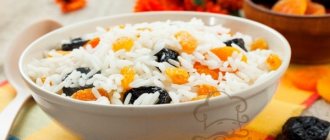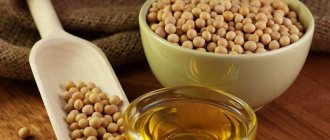What kind of rice is needed for pilaf: selection criteria
If rice porridge is difficult to spoil, then for pilaf there is a whole cooking method.
First of all, this concerns not only the process itself, but also the correct choice of cereals. The final result depends on what type and even the specific variety is used. Rice for pilaf must meet the following characteristics:
- the cereal does not stick together during cooking;
- the grains remain dense, hold their shape, do not stick to each other, but retain their flowability;
- rice absorbs the aromas of spices and fats well;
- the pilaf is painted in a beautiful color.
The friability depends on the amount of paste: the more of it, the more the dish will stick together. For rice, long-grain varieties are most often used, rather than round ones. The latter have more paste, although among them there are several varieties that make excellent pilaf.
Cooking secrets
To prepare the perfect dish recipe, use these helpful tips:
- Cooking technology. The cooking method requires compliance with proportions and proper processing of products. So, rice along with meat and spices is stewed, rather than boiled in water. Therefore, the amount of liquid taken is non-standard - 1:1, less often 1:1.5.
- Spices and vegetables. Additional products are used to add brightness to the pilaf. Onions, carrots and garlic are the basis of the dish, but sometimes cumin grains, barberries, dried fruits and even quince can be added to it. Fresh, ground or dry hot pepper will make the pilaf spicy, and paprika will add sweetness. Turmeric is often added for color and aroma. If you want to make pilaf that is not burdened by an abundance of spices, add simple garlic, salt and black pepper. But it is better not to use ready-made mixtures “for pilaf”.
- Cooking utensils. Delicious pilaf is cooked in a cauldron. Or in another pan with thick walls. You can serve the finished masterpiece in wooden plates.
- Rice variety. No secrets of cooking pilaf will work if you use starchy rice. It is better to choose transparent varieties, strong, not too short and long. High-quality rice absorbs fat and water well. There are special Tajik and Uzbek varieties: white alanga, oshpar, devzira. Can be prepared from brown rice: akmarzhan, saryk, velvet. Indian and Thai varieties are not suitable for Uzbek dishes: basmati, jasmine, wild rice. Steamed varieties should not be used. Instead of the described types, you can use the Italian variety for paella.
- Choosing the right meat. The best lamb to use is chuck, brisket or shoulder. Beef or turkey/chicken will work instead. But veal is not suitable for pilaf.
- Bookmark products. Among all the secrets of cooking, the bookmark takes second place after processing vegetables, meat and rice. The Uzbek name hides the cooking technology: palov osh. First they put onions (piyoz), then carrots (ayoz), and only then meat (lahm). Following them are: fat (olio), salt (wet) and water (about). The onion is cut into half rings to preserve juiciness, and the carrots are chopped into strips.
- Preparation of zirvak (meat base). The meat is fried separately from onions and other products. It is important to use one type of oil or mixture; if the sesame option is chosen, then you need to add it. If a dish is prepared using sunflower oil, then use it. Fry the meat until golden brown. Onions and vegetables can be fried in the leftover product.
Choosing oil for preparing delicious pilaf is an important step. Experimenters may use combinations of plant products. For those who want to get the perfect dish from simple ingredients, it is better to choose refined sunflower oil.
Rice for pilaf - the best types
Cereal grains come in not only different varieties, but also different types. Before being sent for sale, rice undergoes certain processing. The quality of the cereal depends on what it is like.
Three types of rice are usually used for pilaf:
- white;
- brown;
- steamed.
How do these varieties differ from each other?
White rice
It is easy to recognize by the beautiful snow-white color of the grains, which are slightly translucent. This effect is achieved through careful grinding of the grain. By the way, that’s what they call rice – polished. As a result of the procedure, the grains are completely cleared of husks and turn white. There are both round and long grain varieties of white rice. This grain has a long shelf life, and pilaf from it is prepared quickly, in just a quarter of an hour.
Despite a number of advantages, polished varieties also have a disadvantage. They retain very few nutrients.
Brown rice
The most useful type, consisting of unpolished grains of a brownish color. Minimal processing allows you to preserve the maximum of microelements and beneficial properties of the cereal. In addition, brown rice also has a special taste and smell. Pilaf from it acquires an interesting nutty aftertaste with the same aroma. It takes a little longer to cook than white rice - half an hour, but it is low in calories.
The downside of brown rice is its fairly high price. And it doesn't last long.
Parboiled rice
The translucent grains have a golden hue, but during the cooking process they turn completely white. Steaming cereal allows you to retain more nutrients. This rice takes up to 30 minutes to cook, just like unpolished rice. But at the same time it does not need to be pre-soaked for a long time.
Perhaps, besides the high price, parboiled rice has no disadvantages.
Which rice is better to make pilaf from: varieties
Each country has its own brands that produce different cereals, including rice. So, most often you can find on our shelves the products of Zhmenka, Mistral, Agro-Alliance. There is no point in arguing which company is better, because what kind of variety it offers is much more important. And there are a huge variety of them, but not all of them make excellent pilaf.
Among the range of cereals for preparing aromatic and crumbly pilaf, it is better to choose the following varieties of rice:
- Jasmine. Each grain of rice has a characteristic groove and has a floral aroma and aftertaste. The pilaf has an original taste and is free-flowing.
- Pathumthani. Another variety with a floral aroma, but cheaper than the previous one.
- Aquatics. Long grain rice, characterized by the fact that it takes the longest to cook, even if the grain is soaked. But in the end the dish does not suffer from this, quite the contrary. The downside of this variety is its high price.
- Basmati. Cereals from India are also quite expensive. The grains are hard, long and thin, milky in color. They retain their shape when cooked and at the same time lengthen even more. They do not stick together and perfectly absorb fat, juice and spice aromas.
- Laser. The grains are long, white, starchy and soft. The variety is distinguished by the fact that it quickly absorbs water. This allows you to get by with minimal soaking time. Rice takes no more than 40 minutes to cook. The pilaf comes out tender, but crumbly.
- Indica. The grains are long, up to 6 mm, and do not stick together during cooking.
- Camolino. One of the few round-grain varieties that are suitable for pilaf and retain their flowability when cooked.
Excellent pilaf is made from black rice, and it cooks quickly - only 45 minutes. But the price for such cereals is steep. The cereal is grown mainly in Tibet and is subjected to special processing.
Which rice is best to use for Uzbek pilaf?
Pilaf is considered the national Uzbek dish. In this country, everyone knows how to cook it, as well as what grains are needed to obtain the desired consistency.
The most delicious Uzbek pilaf is obtained from the following varieties:
- Devzira. The grain can be milky or darker, almost brick-colored. It is heavier in weight than other varieties due to special processing. The grains are alternately moistened and dried over several years. But then during the cooking process they increase 7 times. The pilaf does not stick together even after cooling, but the rice must first be soaked for a couple of hours.
- Chungara. It is a subspecies of Devzira, but contains more starch. After rinsing, the starchy grain turns into excellent opaque rice. The dish comes out tasty and airy.
- Dastar is a saryk. An excellent variety that absorbs aromas, spices and fats well. The grains do not stick together, and during the cooking process they increase 3 times in volume.
- Alanga. One of the round-grain varieties that do not require soaking. A simple rinse will be enough. The rice grains are small but dense; they double in size when cooked and absorb water well.
Rice for pilaf: should it be washed and soaked?
Regardless of which variety is used, the cereal must be washed. And not just once, but until the water becomes clear. Cloudy water is starch that is washed off from the grains. It is this that glues the grains of rice together during cooking, which means it is not needed in pilaf. The starchy film on the grains also prevents them from being saturated with water, fat, and the aromas of spices. Therefore, you need to rinse the cereal until the water is no longer cloudy.
Long grain rice should be washed very carefully - it is easy to break.
All varieties should be washed, but most still need soaking. This procedure allows you to reduce the cooking time of pilaf. The swollen and water-filled grain will cook less.
How long the soaking will last depends on the specific type and variety of rice:
- for soft varieties like Lazarus, 15–30 minutes are enough;
- hard rice such as Basmati and Devzira need at least 2 hours;
- Black and wild rice should be soaked overnight.
But there is one rule common to all varieties of rice, and it concerns water temperature. It is necessary to soak rice only in hot water, about 65 ° C. Not in cold water - the rice grains do not absorb it well, and then, when cooked, they crack. And not in boiling water - then a glutenous film forms on the grains, preventing the absorption of aromas.
Processing rice before cooking pilaf
Do I need to rinse rice?
To prevent sticking, the rice must be washed. This is also necessary to get rid of small debris and dust.
See also: Side dishes and sauces for fish cutlets
You can rinse in a saucepan or sieve. For convenience, it is better to use a large and deep bowl.
After pouring the rice into a container, add hot water and stir lightly with your hands. Rinsing is repeated 5-7 times, changing the liquid each time. If necessary, you can do more, the main thing is that the water becomes clear.
Is it necessary and how to soak rice?
After washing, the cereal does not need to be soaked. This is done for faster cooking.
Depending on the variety, they are soaked in different ways:
- Long grain (but not fine). Scald the rice with boiling water and add cold water. Leave for 30 minutes and dry with a towel.
- Round grain. A 15-minute soak in warm water is enough. Then you need to rinse it again with cold water.
- Small and transparent. To prepare a crumbly dish, such rice is soaked for 5 hours, and the water is added with salt.
How to fry rice for pilaf
Frying is necessary to make the dish crumbly. The washed cereal is poured into a dry frying pan and dried over medium heat, then a small amount of oil is added and fried for 3-5 minutes over medium heat until golden brown.
How to maintain the correct proportions of cereals, meat, vegetables and water
With meat and vegetables everything is simple. The classic recipe for real Uzbek pilaf stipulates that everything should be equally divided. That is, the main ingredients of pilaf (rice, meat, carrots) should be in equal proportions, for example, 1 kg each. However, no one forbids changing them in one direction or another. You can take less meat, but more vegetables. Or reduce the proportions of cereals in favor of the same vegetables. And absolute freedom in terms of spices: it can be either a traditional set of spices for pilaf or individual solutions.
But when it comes to water, it is important to maintain the correct proportions. If you add more, even the best rice will turn out not to be pilaf, but to be a viscous porridge.
Each variety has its own ratio of cereals and water:
- round rice - filled with water 1:1;
- steamed varieties, pre-soaked - also 1:1, and laid dry - 1:2;
- Basmati – 1:1.3;
- Devzira – 1:2;
- brown rice – 1:3;
- black rice – 1:4.
Which rice is best for pilaf, each housewife decides for herself, testing different varieties. Some people prefer a soft and tender dish, others prefer that the grains of rice remain elastic. But culinary experts agree on one thing: pilaf should crumble, smell delicious and look appetizing. And this result can only be achieved by taking the right grains and following the cooking technology. However, this is not at all difficult, you just need the desire to please yourself and your loved ones with a delicious dish.
Recipe for pilaf with cumin [with video]
True pilaf is always prepared from young lamb. In this case, the meat turns out juicy and not tough. To surprise your guests with a real oriental dish, you should carefully follow the proposed recipe.
✍ Ingredients:
- lamb meat – 1 kg;
- rice – 1 kg;
- lard – 100 g;
- carrots – 1 kg;
- onions – 3-5 pcs.;
- garlic – 2 heads;
- hot pepper – 1 pod;
- vegetable oil – 150 ml;
- salt - to taste;
- water – 1 l;
- zira – 1.5 tsp.
Preparation:
- In a well-heated cauldron, fry pieces of lard until golden brown and transfer them to a separate container.
- Fry the lamb pieces for 10 minutes, remembering to stir, and add a pinch of cumin.
- Add chopped onion and cook until golden.
- Place carrots cut into thin strips into a cauldron and fry for 10 minutes.
- Pour in just enough cold water to cover the roast by a maximum of 2.5 cm. Properly prepared “zirvak” (broth) is a guarantee of success in preparing the dish.
- After the broth boils, add whole pepper pods, garlic cloves, and salt.
- Reduce heat and simmer for 30 minutes, then remove the pepper and garlic.
- Place the washed rice into the bubbling broth and distribute evenly over the meat without stirring.
- After the rice has absorbed the broth, add a glass of hot water, cover with a lid and wrap in a towel.
- Reduce heat to low and cook for about 10 minutes more.
- Turn off the heat and leave the pilaf for half an hour to “ripen”.
- Mix the finished dish, place on a large round dish, garnish with garlic and pepper, and serve.
See also: How long can cutlets be stored in the refrigerator
Video recipe for preparing real Uzbek pilaf
When preparing carrots, it is recommended to sprinkle them with sugar. This is necessary to release the juice.











